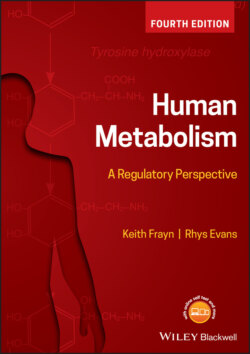Читать книгу Human Metabolism - Keith N. Frayn - Страница 32
Box 1.6 High-energy bonds
ОглавлениеThe term ‘high-energy bond’ is not strictly accurate. They are not ‘special’ bonds, but rather they release their free energy when hydrolysed. They may be denoted ∼, and it can be seen that ADP can act as a source of energy when its terminal phosphate group is hydrolysed to AMP.
AMP: Ad-P
ADP: Ad-P∼P
ATP: Ad-P∼P∼P
ADP has a special role in bioenergetics because beside acting as a (limited) energy source in its own right, its availability is one factor that regulates the rate of ATP synthesis.
A close structural analogue of adenosine triphosphate (ATP) is guanosine triphosphate (GTP) which also carries energy. The presence of these two forms of energy carriage likely represents a form of metabolic compartmentation, separating pathways by their molecular preferences. GTP also has a function in regulation, especially in signal transduction involving G-proteins.
The energy for the phosphorylation is derived from the electrons contained in the reduced forms of the electron carriers. As the electron is passed sequentially down a series of carriers, the released energy is harnessed. The mechanism responsible is the electron transport chain, located in the inner mitochondrial membrane (IMM). The IMM is a highly specialised membrane which is extremely selectively impermeable. It comprises four protein complexes (complex I, II, III, IV) together with a loosely associated cytochrome (cytochrome c) and the (non-protein) quinone CoQ10 (ubiquinone). All these components have variable redox states and act as electron acceptors (oxidising agents) and electron donors (reducing agents); they can function as electron carriers by shifting between their reduced (electron containing) and oxidised (electron deficient) forms. To facilitate this, the proteins contain transition metals (Fe, Cu), complexed in prosthetic groups (e.g. haem) or complexed to sulphur (Fe-S centres) which are readily capable of gaining or losing an electron. They are organised in a sequential arrangement within the IMM such that the electrons are passed down a gradual incremental energy gradient. Complex I oxidises NADH back to NAD+, whilst complex II oxidises FADH2 back to FAD, both passing electrons (as pairs) to CoQ10, thence to complex III, then cytochrome c, and eventually to complex IV. Complex IV, the final redox protein in the chain, combines the electrons it receives with molecular oxygen (O2, the final electron acceptor), reducing it to water. Complexes I, III, and IV use the energy of electron transfer to pump protons (H+) out of the mitochondrial matrix across the IMM and into the intermembrane space beyond. This creates an electrochemical gradient between the inside and outside of the mitochondrion. The energy of this H+ gradient is finally utilised to drive phosphorylation of ADP to ATP: the protons can only re-enter the mitochondrial matrix by passing through ATP synthase (Fo/F1 ATPase; also called complex V although it is not a part of the actual electron transport chain), another IMM-spanning protein. Proton passage through this large protein complex provides the energy for ATP synthesis (the chemiosmotic process). Hence, provided the IMM is otherwise impermeable to protons, the oxidation of NADH/FADH2 by electron transport is tightly coupled to the phosphorylation of ADP to ATP. However, if protons leak through the IMM back into the mitochondrial matrix, the gradient is dissipated (‘uncoupled’) and ATP synthesis cannot occur, leading to mitochondrial inefficiency. The final step in metabolism is the export of ATP out of the mitochondrion and into the cytosol, and this is achieved by an adenine nucleotide translocator also spanning the IMM.
In the remainder of this chapter, we will outline the major metabolic pathways of ‘energy metabolism’ that will be considered further in this book, signposting the reader to where these are discussed in more detail.
